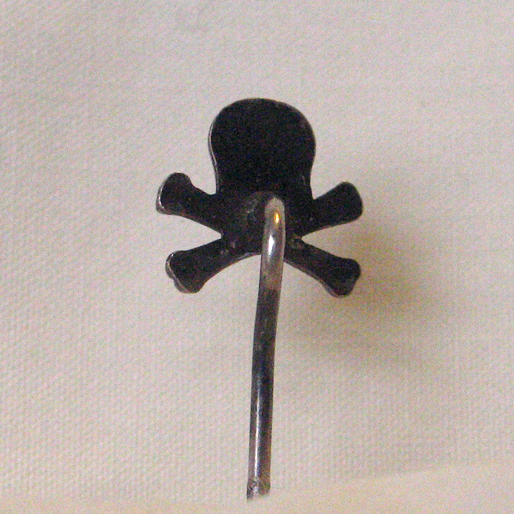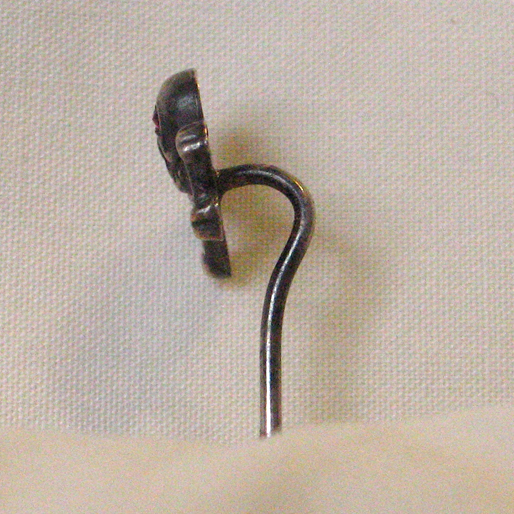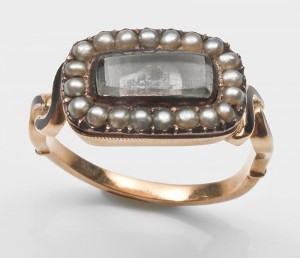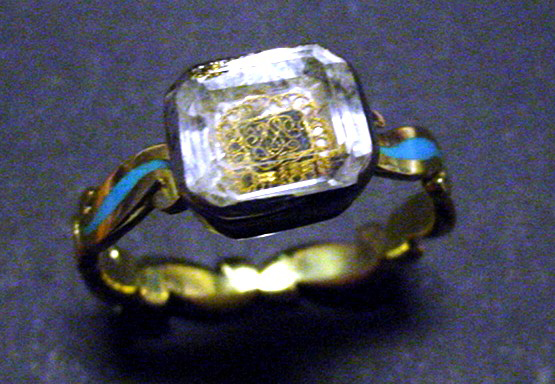Adding Some Flesh to a Skull & Crossbones Pin
It’s always the odd one out.
Among the more common questions I receive at Art of Mourning revolve around the strange, the unusual and the different. It’s often when I’m faced with one of these that I know there often won’t be a definitive answer, which is something many find difficult to grapple with, but it makes the learning of the piece all the more special.
So, after my initial complaint of ‘why, oh why couldn’t this be an easy one?’, I sit back and take a deeper look at the piece in question. The wonderful thing about memorial and sentimental jewels is that no jewel was given without at least some sort of sentiment attached and with mourning jewels, people automatically attach the title to anything with a memento mori symbol.
With that in mind, let’s look at this charming little skull and crossbones pin with ruby eyes. Defining a date for such an item isn’t an easy task, one must step back from it and consider these questions;
- What is the purpose of the piece?
- Why would it have been worn?
- What are its materials?
- Does the skull conform to any other popular styles of skull design?
Once you start to apply this thinking to a piece, you begin to get a better idea of how to understand it. Think of it as a big problem solving exercise and each piece of the puzzle will come together. Of course, I’ve spent half my life studying these items, but you can find more than enough information on the internet (this very site) or at your local library.
So, to the questions! The purpose of the piece is rather simple. The function of the pin, being only small in size and lacking a fastening clasp or area at the bottom for a clip, hence the ornamental nature of the piece is underlined. Along with this, the ruby eyes offset its functional nature and create a more aesthetic quality (which conflicts with the purpose of the skull). So, was this a hat/tie pin or worn as a token on the lapel? Sadly, the true answer lies with the person who bought it (I’m hesitant to say ‘commissioned’, but we’ll get to that later).
Why would it have been worn? As discussed, this piece served a purpose, be it aesthetic or otherwise. Why it would have been worn is the prerogative of the wearer, but what we have to consider is not simply the mindset of the wearer, but the time in which a pin of this sort would be a noteworthy gift or in fashion. From this, we have a broad length of time, ranging from the mid/latter 18th century to the mid 20th. That is obviously quite a lot of time to cover, but it suits the method in which pins for decoration correlate enough with functional fashion to be anything more than a curious trinket and become a sentimental gift.
Here is where we look at the piece and say that, underneath its age, we have a silver (unstamped) piece with ruby eyes, so it obviously wasn’t on the bottom end of when it was made. We can make assumptions of the 1880 period and the swing towards silver as a popular material and thusly look at the resurgence of the memento mori symbolism during that time as affecting this piece, or we can look to the previous century and assume that this is not about a dedication or memorial, but a trinket of mortality for a gentleman on a ‘grand tour’ of the continent. This would facilitate the use of the silver (rather than gold) and be an appealing gift.

The skull is the most revealing aspect of the piece. This is mostly due to the symbolism – it’s not simply the skull, but the skull and crossbones. Its style is incredibly simplistic and naive, without a clearly defined style of skull or bones, which leans towards its being more trinket-based, rather than a fine, bespoke piece of jewellery. Grooves over the eyes and the large nostrils defy the 19th century and onward styles that craft the well-defined skull and the motifs that we recognise mostly today. That is, however, not taking into account the memento mori revival period of the latter 19th century (which was not ubiquitous, but certainly a prolific niche) which used silver to make pieces like this and other peripherals, such as walking stick handles. This style, popular in the UK, was also consistent through France to Eastern Europe and remained to before WWI.
Fraternal Orders are the other, more common, bodies that appropriated the skull and crossbones motif and this particular pin aligns closely with Mason styles that can be seen here. With this pin, the addition of the crossbones does skew towards a Fraternal derivative, as this defies the simple skull.
In our little journey, we’ve covered a lot of ground in trying to understand what this piece truly is. Much of the time, it’s obvious to see when something was created to deceive (a copy or style in order to fetch a higher price) or when it was simply made recently and not fully understood, but they often have a clearer prerogative and are easier to spot.
I hope you enjoyed that as much as I did, nothing pleases me more than to look at a piece of jewellery, no matter what condition or style and appreciate it like a glass of fine wine.
Take some of what you’ve learned here and apply it to your jewellery. Perhaps you’d like to join our Facebook group and tell the collecting community what you’ve found?








